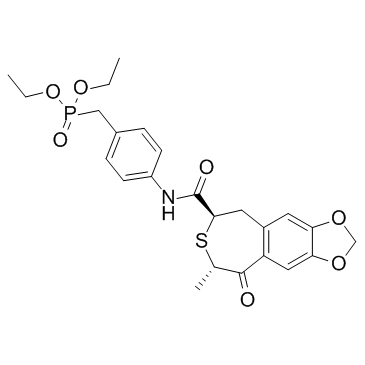TAK-778 |
| Catalog No.GC34175 |
TAK-778 is a derivative of ipriflavone and has been shown to induce bone growth in in vitro and in vivo models.
Products are for research use only. Not for human use. We do not sell to patients.

Cas No.: 180185-61-9
Sample solution is provided at 25 µL, 10mM.
TAK-778 is a derivative of ipriflavone and has been shown to induce bone growth in in vitro and in vivo models.
TAK-778 is a derivative of ipriflavone and has been shown to induce bone growth in in vitro and in vivo models.Continuous treatment with TAK-778 (10 μM) for 1 to 21 days results in an increase in the area of mineralized nodules. TAK-778 at concentrations of 1 μM and higher significantly stimulates the activity of cellular Alkaline phosphatase (ALP). TAK-778 increases slightly but significantly the DNA content of the cells at the confluence stage. Treatment with TAK-778 also results in dose-dependent increases in the amount of soluble collagen and osteocalcin secreted into culture medium from days 5 to 7. TAK-778 enhances the secretion of both TGF-β and IGF-I at every time point during the 21 days of culture. Treatment of the cells with TAK-778 does not induce ALP activity, but does result in a dose-dependent increase in the saturated cell density. TAK-778 at a concentration of 10 μM significantly reduces the saturated cell density[2].
Treatment with a single local application of TAK-778/PLGA-MC (0.2 to 5 mg/site) results in a dose-dependent increase in the radio-opaque area formed in the defect. Histological studies show the defect area is occupied by a bony bridge and the newly-formed radio-opaque area corresponds to a calcified bone containing bone marrow cavities surrounded by thick osteoid seams with cuboidal osteoblasts. There is no significant difference in either of the indices between placebo- or TAK-778/PLGA-MC-treated skulls. Two months after the operation, the TAK-778/PLGA-MC pellets induce radiological osseous union across the defects[2]. Oral treatment of OVX rats with TAK-778 causes a more pronounced increase in bone mineral density (BMD) of the lumbar vertebrae compare to vehicle controls[3].
[1]. Rosa AL, et al. TAK-778 enhances osteoblast differentiation of human bone marrow cells via an estrogen-receptor-dependent pathway. J Cell Biochem. 2004 Mar 1;91(4):749-55. [2]. Notoya K, et al. Enhancement of osteogenesis in vitro and in vivo by a novel osteoblast differentiation promoting compound, TAK-778. J Pharmacol Exp Ther. 1999 Sep;290(3):1054-64. [3]. Cai M, et al. TAK-778 induces osteogenesis in ovariectomized rats via an estrogen receptor-dependent pathway. J Bone Miner Metab. 2011 Mar;29(2):168-73.
Average Rating: 5 (Based on Reviews and 20 reference(s) in Google Scholar.)
GLPBIO products are for RESEARCH USE ONLY. Please make sure your review or question is research based.
Required fields are marked with *




















